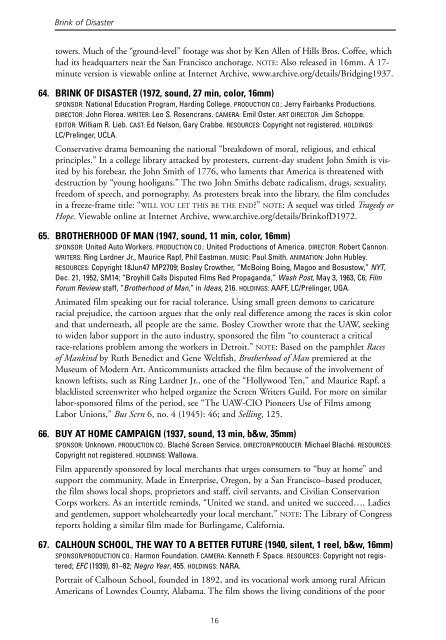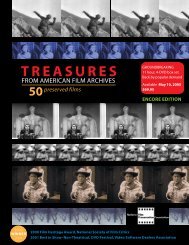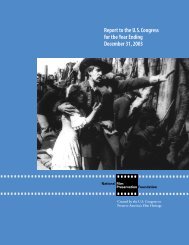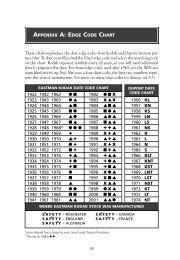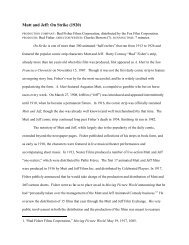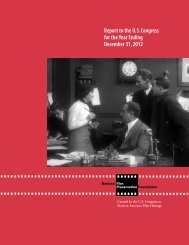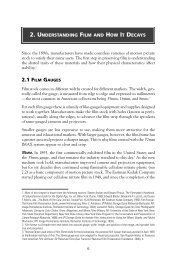Field Guide to Sponsored Films - National Film Preservation ...
Field Guide to Sponsored Films - National Film Preservation ...
Field Guide to Sponsored Films - National Film Preservation ...
You also want an ePaper? Increase the reach of your titles
YUMPU automatically turns print PDFs into web optimized ePapers that Google loves.
Brink of Disaster<br />
<strong>to</strong>wers. Much of the “ground-level” footage was shot by Ken Allen of Hills Bros. Coffee, which<br />
had its headquarters near the San Francisco anchorage. NOTE: Also released in 16mm. A 17minute<br />
version is viewable online at Internet Archive, www.archive.org/details/Bridging1937.<br />
64. BRINK OF DISASTER (1972, sound, 27 min, color, 16mm)<br />
SPONSOR: <strong>National</strong> Education Program, Harding College. PRODUCTION CO.: Jerry Fairbanks Productions.<br />
DIRECTOR: John Florea. WRITER: Leo S. Rosencrans. CAMERA: Emil Oster. ART DIRECTOR: Jim Schoppe.<br />
EDITOR: William R. Lieb. CAST: Ed Nelson, Gary Crabbe. RESOURCES: Copyright not registered. HOLDINGS:<br />
LC/Prelinger, UCLA.<br />
Conservative drama bemoaning the national “breakdown of moral, religious, and ethical<br />
principles.” In a college library attacked by protesters, current-day student John Smith is visited<br />
by his forebear, the John Smith of 1776, who laments that America is threatened with<br />
destruction by “young hooligans.” The two John Smiths debate radicalism, drugs, sexuality,<br />
freedom of speech, and pornography. As protesters break in<strong>to</strong> the library, the film concludes<br />
in a freeze-frame title: “WILL YOU LET THIS BE THE END?” NOTE: A sequel was titled Tragedy or<br />
Hope. Viewable online at Internet Archive, www.archive.org/details/BrinkofD1972.<br />
65. BROTHERHOOD OF MAN (1947, sound, 11 min, color, 16mm)<br />
SPONSOR: United Au<strong>to</strong> Workers. PRODUCTION CO.: United Productions of America. DIRECTOR: Robert Cannon.<br />
WRITERS: Ring Lardner Jr., Maurice Rapf, Phil Eastman. MUSIC: Paul Smith. ANIMATION: John Hubley.<br />
RESOURCES: Copyright 18Jun47 MP2709; Bosley Crowther, “McBoing Boing, Magoo and Bosus<strong>to</strong>w,” NYT,<br />
Dec. 21, 1952, SM14; “Broyhill Calls Disputed <strong><strong>Film</strong>s</strong> Red Propaganda,” Wash Post, May 3, 1963, C6; <strong>Film</strong><br />
Forum Review staff, “Brotherhood of Man,” in Ideas, 216. HOLDINGS: AAFF, LC/Prelinger, UGA.<br />
Animated film speaking out for racial <strong>to</strong>lerance. Using small green demons <strong>to</strong> caricature<br />
racial prejudice, the car<strong>to</strong>on argues that the only real difference among the races is skin color<br />
and that underneath, all people are the same. Bosley Crowther wrote that the UAW, seeking<br />
<strong>to</strong> widen labor support in the au<strong>to</strong> industry, sponsored the film “<strong>to</strong> counteract a critical<br />
race-relations problem among the workers in Detroit.” NOTE: Based on the pamphlet Races<br />
of Mankind by Ruth Benedict and Gene Weltfish, Brotherhood of Man premiered at the<br />
Museum of Modern Art. Anticommunists attacked the film because of the involvement of<br />
known leftists, such as Ring Lardner Jr., one of the “Hollywood Ten,” and Maurice Rapf, a<br />
blacklisted screenwriter who helped organize the Screen Writers Guild. For more on similar<br />
labor-sponsored films of the period, see “The UAW-CIO Pioneers Use of <strong><strong>Film</strong>s</strong> among<br />
Labor Unions,” Bus Scrn 6, no. 4 (1945): 46; and Selling, 125.<br />
66. BUY AT HOME CAMPAIGN (1937, sound, 13 min, b&w, 35mm)<br />
SPONSOR: Unknown. PRODUCTION CO.: Blaché Screen Service. DIRECTOR/PRODUCER: Michael Blaché. RESOURCES:<br />
Copyright not registered. HOLDINGS: Wallowa.<br />
<strong>Film</strong> apparently sponsored by local merchants that urges consumers <strong>to</strong> “buy at home” and<br />
support the community. Made in Enterprise, Oregon, by a San Francisco–based producer,<br />
the film shows local shops, proprie<strong>to</strong>rs and staff, civil servants, and Civilian Conservation<br />
Corps workers. As an intertitle reminds, “United we stand, and united we succeed…. Ladies<br />
and gentlemen, support wholeheartedly your local merchant.” NOTE: The Library of Congress<br />
reports holding a similar film made for Burlingame, California.<br />
67. CALHOUN SCHOOL, THE WAY TO A BETTER FUTURE (1940, silent, 1 reel, b&w, 16mm)<br />
SPONSOR/PRODUCTION CO.: Harmon Foundation. CAMERA: Kenneth F. Space. RESOURCES: Copyright not registered;<br />
EFC (1939), 81–82; Negro Year, 455. HOLDINGS: NARA.<br />
Portrait of Calhoun School, founded in 1892, and its vocational work among rural African<br />
Americans of Lowndes County, Alabama. The film shows the living conditions of the poor<br />
16


